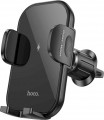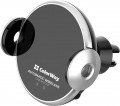The method of fixation provided by the design of the holder.
The main methods of such fixation are
on a suction cup,
on an air duct grille and
on an adhesive surface. Rarer options are
on the dashboard,
on the headrest,
in the CD slot,
on the rearview mirror,
on the handlebars of a bicycle or motorcycle,
clamps / clips,
non-standard and
free-standing mounts. There are devices that combine several options at once - for example, on a suction cup and on a grille using a clothespin. At the same time, in some models, different types of fasteners are initially included in the kit, in others, the fixation method depends on the modification; these nuances should be clarified when choosing. As for the features of each of the individual types of fasteners, they are as follows:
— Suction cup. The suction cup allows you to attach the device to the dashboard, windshield or any other relatively flat surface. At the same time, unlike a sticker, such a mount is reusable. On the other hand, suction cups are generally less reliable, and on rough and textured surfaces they hold poorly, or do not hold at
...all.
— On the air duct grille. Mounting on the air duct grille is one of the most popular ways to install the holder in the car. The fact is that air duct openings are available on almost any dashboard, and they are usually located quite conveniently for installing holders. Directly according to the methods of mount the model to the ventilation grille, clamps, clothespins or hooks can be used.
— Adhesive surface. Fastening with a special adhesive pad — similar to installation with double-sided tape (only in this case the “tape” is initially attached to the device body, and before installation it is enough to remove the protective film on the adhesive surface). This type of mount is suitable for both completely smooth and embossed surfaces, it is stronger than suction cups, but it is disposable — it is not easy to remove the installed device, and the fastener itself usually does not imply reuse. Therefore, such fasteners are rarely used in their pure form — most often they are provided as a spare (or alternative) option for mount to the grill.
— On the dashboard. The holder is attached to the elements of the dashboard in the car interior using a special clamp that can be adapted to different surface thicknesses. A striking example of the use of such a fastener is the placement of a smartphone on the characteristic arc of the "dashboard" in the area behind the steering wheel.
— On the headrest. A convenient option for attaching a smartphone or even a tablet for passengers in the back seat of a vehicle. As a rule, such holders have two “paws” with an adjustable extension in width, which cling to the headrest pins. The second option for implementing the mount is fixing it on the headrest using Velcro or a strap.
— On the handlebar. Fastening to the handlebar of a bicycle, motorcycle or other similar vehicle. The basis of such mount is usually a ring-clamp, which is put on the handlebar tube and firmly fixed to it.
— Into the CD slot. Such holders are equipped with special spacers that are inserted into the empty CD slot of a standard or non-original car radio and are securely fixed in it. The gadget fixed in the holder is visible to the driver and allows for the efficient use of the unused CD slot.
— On the rearview mirror. Typically, such holders are fixed with clamps or adjustable brackets around the rearview mirror in the car. A platform for installing a mobile device is placed on the adjustable rod from such a fastener. The smartphone placed under the rearview mirror is in a convenient place for the driver — its functions can be used without being distracted from the road.
— Clamp/clip. A clamp is a tabletop fastener based on a screw mechanism with one fixed jaw, the second one can move back and forth when the screw is turned. When the clamp is tightened, the jaws squeeze the flat surface of the table, fixing the holder on it. A clip is a fastener in the form of a large clothespin, consisting of two halves that are attracted to each other by a spring. Clips are less reliable than clamps, which is why they are used mainly among tabletop models of relatively small "load capacity".
— Non-standard. Fastening devices that do not fall under the standard common types of fastenings. In particular, this category includes models with installation in a cup holder and similar solutions.Clamp width in millimeters provided by the holder or stand.
In this case, the width of the clamp means the maximum distance that the gadget fasteners can be spread. In other words, this is the maximum size of the smartphone, which can be hold.
The parameter determines whether it can be used in conjunction with a holder or stand for gadgets with a designated range of screen diagonal dimensions in inches. As a rule, it is customary to indicate the maximum allowable diagonal of the display of the device, which can be fixed in the jaws of the holding device.

